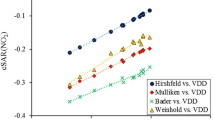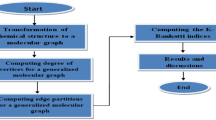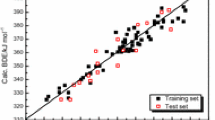Abstract
The relationship of urea adductability of substituted cyclic organic compounds with topological descriptors has been investigated. Wiener’s index—a distance-based topological descriptor, molecular connectivity index—an adjacency-based topological descriptor and eccentric connectivity index—an adjacency-cum-distance based topological descriptor were employed for the present study. A data set comprising of 45 cyclic organic compounds was utilized. The values of all the three topological indices for every compound involved in the data set were computed using in-house computer program. The resultant data was analyzed and suitable models were developed after identification of adductible ranges. Subsequently, each compound in the data set was classified using these models either as urea adductible or non-adductible, which was then compared with the reported adductability in urea. Accuracy of prediction was found to vary from a minimum of 90% for a model based upon eccentric connectivity index to a maximum of 92% for model based upon Wiener’s index. Statistical analysis revealed the selected topological indices to be weakly or appreciably intercorrelated for the said data set.



Similar content being viewed by others
References
Hollingsworth, M.D., Harris, K.D.M.: Urea inclusion compounds. In: Atwood, J.L., Davis, J.E.D., Macnicol, D.D., Vogtle, F. (eds.) Comprehensive Supramolecular Chemistry. Solid State Supramolecular Chemistry-Crystal Engineering, vol. 6, pp. 177–237. Pergamon Press, Oxford (1996).
Harris, K.D.M.: Urea Inclusion Compounds. In: Atwood, J.L., Steed, J.W. (eds.) Encyclopedia of Supramolecular Chemistry, vol. 2, pp. 1538–1549. Marcel Dekker, New York (2004).
Vaughan, P., Donohue, J.: The structure of urea. Interatomic distances and resonance in urea and related compounds. Acta Crystallogr. 5, 530–535 (1952).
Smith, A.E.: The crystal structure of urea–hydrocarbon complexes. Acta Crystallogr. 5, 224–235 (1952).
Harris, K.D.M., Thomas, J.M.: Structure aspects of urea inclusion compounds and their investigations by x-ray diffraction: a general discussion. J. Chem. Soc., Faraday Trans. 86, 2985–2996 (1990).
Frank, S.G.: Inclusion compounds. J. Pharm. Sci. 64, 1585–1604 (1975).
Harris, K.D.M., Smart, S.S., Hollingsworth, M.D.: Structural properties of α, ω-dibromoalkane/urea inclusion compounds: a new type of interchannel guest molecule ordering. J. Chem. Soc. Faraday Trans. 87, 3423–3429 (1991).
Clement, R., Mazieres, C., Guibe, L.: Low temperature phase transition in urea-trioxane inclusion compounds. J. Solid State Chem. 5, 436–440 (1972).
Lenne, H.U., Mez, H.C., Schlenk, W.: The lengths of molecules in inclusion channels of urea and thiourea. Liebigs Ann. Chem. 73, 70–96 (1968).
Smart, S.S., Baghdadi, A.E., Guillaume, F., Harris, K.D.M.: Conformational and vibrational properties of α, ω- dihalogenoalkane/urea inclusion compounds: a Raman scattering investigation. J. Chem. Soc. Faraday Trans. 90, 1313–1322 (1994).
Hayes, D.G., Alstine, J.V., Setterwall, F.: Urea-based fractionation of fatty acids and glycerides of polyunsaturated and hydroxy fatty acid seed oils. J. Am. Oil Chem. Soc. 77, 207–215 (2000).
Bishop, R., Dance, I.G.: New type of helical inclusion networks. Top. Curr. Chem. 149, 139–188 (1988).
Takemoto, K., Sonoda, N.: Inclusion compounds of urea, thiourea and selenourea. In: Atwood, J.W., Davis, J.E.D., MacNicol, D.D. (eds.) Inclusion Compounds, vol. 2, pp. 47–67. Academic Press, London (1984).
Findlay, R.A.: Adductive crystallization. In: Schoen, H.M., Mcketta, J.J. (eds.) Interscience Library of Chemical Engineering and Processing. New Chemical Engineering Separation Techniques, vol. 1, pp. 257–318. Interscience Publishers, New York (1962).
Thakral, S., Madan, A.K.: Topological models for prediction of adductability of branched aliphatic compounds in urea. J. Inclusion Phemon. Macrocyclic Chem. 56, 405–412 (2006).
Estrada, E., Uriate, E.: Recent advances on the role of topological indices in drug discovery research. Current Med. Chem. 8, 1573–1588 (2001).
Nikolic, S., Kovacevic, G., Milicevic, A., Trinajstic, N.: The Zagreb Indices: thirty years after. Croat. Chem. Acta 76, 113–124 (2003).
Gozalbes, R., Doucet, J., Derouin, F.: Application of topological descriptors in QSAR and drug design: history and new trends. Curr. Drug Targets Infect. Disord. 2, 93–102 (2002).
Wiener, H.: Correlation of heats of isomerization, and differences in heats of vaporization of isomers, among the paraffin hydrocarbons. J. Am. Chem. Soc. 69, 2636–2638 (1947).
Wiener, H.: Structural determination of paraffin boiling points. J. Am. Chem. Soc. 69, 17–20 (1947).
Balaban, A.T.: Topological indices based on topological distances in molecular graphs. Pure Appl. Chem. 55(2), 199–206 (1983).
Hosoya, H.: Topological indices as a sorting device for coding chemical structures. J. Chem. Doc. 12, 181–183 (1972).
Randic, M.: On characterization of molecular branching. J. Am. Chem. Soc. 97(23), 6609–6615 (1975).
Gutman, I., Randic, M.: Algebraic characterization of skeletal branching. Chem. Phys. Lett. 47, 15–19 (1977).
Sharma, V., Goswami, R., Madan, A.K.: Eccentric connectivity index: a novel highly discriminating topological descriptor for structure-property and structure-activity studies. J. Chem. Inf. Comput. Sci. 37, 273–282 (1997).
Kumar, V., Madan, A.K.: Topological models for the prediction of cyclindependent kinase 2 inhibitory activity of aminothiazoles. MATCH Commun. Math. Comput. Chem. 51, 59–78 (2004).
Swern, D.: Urea and thiourea complexes in separating organic compounds. Ind. Eng. Chem. 47, 216–221 (1955).
Schiessler, R.W., Flitter, D.: Urea and thiourea adduction of C5–C42-hydrocarbons. J. Am. Chem. Soc. 74, 1720–1723 (1950).
Truter, E.V.: Urea complexes of some branched-chain and cyclic esters. J. Chem. Soc. 2416–2419 (1951).
Linstead, R.P., Whallwy, M.: The formation of crystalline complexes between urea and esters, and their application to separation of mixtures of esters. J. Chem. Soc. 2987–2989 (1950).
Zimmerschied, W.J., Dinerstein, R.A., Wietkamp, A.W., Marschner, R.F.: Complexes of urea with linear aliphatic compounds. J. Am. Chem. Soc. 71, 2947 (1949).
Redlich, O., Gable, C.M., Dunlop, A.K., Millar, R.W.: Addition compounds of urea and organic substances. J. Am. Chem. Soc. 72, 4153–4160 (1950).
Mima, H., Nishikawa, M.: Inclusion compounds of α-lipoic acid methyl ester with urea and thiourea. J. Pharm. Sci. 53, 931–934 (1964).
Gupta, S., Singh, M., Madan, A.K.: Predicting anti-HIV activity: computational approach using a novel topological descriptor. J. Comput. Aided Mol. Des. 15, 671–678 (2001).
Gupta, S., Singh, M., Madan, A.K.: Application of graph theory: relationship of molecular connectivity index and atomic molecular connectivity index with anti-HSV activity. J. Mol. Struct. (Theochem) 571, 142–152 (2000).
Author information
Authors and Affiliations
Corresponding author
Rights and permissions
About this article
Cite this article
Thakral, S., Madan, A.K. Topological models for prediction of adductability of substituted cyclic organic compounds in urea. J Incl Phenom Macrocycl Chem 58, 321–326 (2007). https://doi.org/10.1007/s10847-006-9160-8
Received:
Accepted:
Published:
Issue Date:
DOI: https://doi.org/10.1007/s10847-006-9160-8




